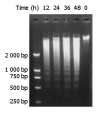Inhibition of DNA primase and induction of apoptosis by 3,3'-diethyl-9-methylthia-carbocyanine iodide in hepatocellular carcinoma BEL-7402 cells
- PMID: 14966908
- PMCID: PMC4716971
- DOI: 10.3748/wjg.v10.i4.514
Inhibition of DNA primase and induction of apoptosis by 3,3'-diethyl-9-methylthia-carbocyanine iodide in hepatocellular carcinoma BEL-7402 cells
Abstract
Aim: To evaluate the effects of 3,3'-diethyl-9-methylthia-carbocyanine iodide (DMTCCI) on DNA primase activity and on apoptosis of human hepatocellular carcinoma BEL-7402 cells.
Methods: DNA primase assay was used to investigate DNA primase activity. MTT assay was applied to determine cell proliferation. Flow cytometric analysis, transmission electron microscopy, DNA fragmentation assay were performed to detect DMTCCI-induced apoptosis. Expression levels of p53, Bcl-2, Bcl-xL, Bad, Bax, survivin, Caspase-3 and poly (ADP-ribose) polymerase (PARP) were evaluated by immunoblot analysis. Caspase-3 activity was assessed with ApoAlert Caspase-3 colorimetric assay kit.
Results: DMTCCI had inhibitory effects on eukaryotic DNA primase activity with IC(50) value of 162.2 nmol/L. It also inhibited proliferation of human hepatocellular carcinoma BEL-7402 cells with IC(50) value of 2.09 micromol/L. Furthermore, DMTCCI-induced BEL-7402 cell apoptosis was confirmed by DNA fragmentation (DNA ladders and sub-G1 formation) and transmission electron microscopy (apoptotic bodies formation). During the induction of apoptosis, expression of Bcl-2, Bcl-xL and survivin was decreased, and that of p53, Bad and Bax was increased. Caspase-3 was activated and poly (ADP-ribose) polymerase (PARP) was cleaved in BEL-7402 cells treated with DMTCCI.
Conclusion: The present data suggest that DMTCCI has inhibitory effects on eukaryotic DNA primase and can induce apoptosis of BEL-7402 cells. The modulation of expression of p53 and Bcl-2 family proteins, and activation of Caspase-3 might be involved in the induction of apoptosis.
Figures













Similar articles
-
Apoptosis induced by DNA primase inhibitor 3,3'-diethyl-9-methylthia-carbocyanine iodide in human leukemia HL-60 cells.Yao Xue Xue Bao. 2006 Oct;41(10):978-84. Yao Xue Xue Bao. 2006. PMID: 17184117
-
Dioscin suppresses hepatocellular carcinoma tumor growth by inducing apoptosis and regulation of TP53, BAX, BCL2 and cleaved CASP3.Phytomedicine. 2016 Nov 15;23(12):1329-1336. doi: 10.1016/j.phymed.2016.07.003. Epub 2016 Jul 5. Phytomedicine. 2016. PMID: 27765352
-
Survivin antisense compound inhibits proliferation and promotes apoptosis in liver cancer cells.World J Gastroenterol. 2005 Jan 14;11(2):193-9. doi: 10.3748/wjg.v11.i2.193. World J Gastroenterol. 2005. PMID: 15633214 Free PMC article.
-
Role of apoptosis in the response of lung carcinomas to anti-cancer treatment.Ann N Y Acad Sci. 2000;926:204-16. doi: 10.1111/j.1749-6632.2000.tb05613.x. Ann N Y Acad Sci. 2000. PMID: 11193036 Review.
-
Apoptosis Detection Methods in Diagnosis of Cancer and Their Potential Role in Treatment: Advantages and Disadvantages: a Review.J Gastrointest Cancer. 2021 Jun;52(2):422-430. doi: 10.1007/s12029-020-00576-9. Epub 2021 Jan 4. J Gastrointest Cancer. 2021. PMID: 33392962 Review.
Cited by
-
Structures to complement the archaeo-eukaryotic primases catalytic cycle description: What's next?Comput Struct Biotechnol J. 2015 May 2;13:339-51. doi: 10.1016/j.csbj.2015.04.006. eCollection 2015. Comput Struct Biotechnol J. 2015. PMID: 25987967 Free PMC article. Review.
-
Pancreatic beta cells persistently infected with coxsackievirus B4 are targets of NK cell-mediated cytolytic activity.Cell Mol Life Sci. 2020 Jan;77(1):179-194. doi: 10.1007/s00018-019-03168-4. Epub 2019 Jun 6. Cell Mol Life Sci. 2020. PMID: 31172216 Free PMC article.
-
Structure-activity relationship of cyanine tau aggregation inhibitors.J Med Chem. 2009 Jun 11;52(11):3539-47. doi: 10.1021/jm900116d. J Med Chem. 2009. PMID: 19432420 Free PMC article.
References
-
- Arezi B, Kuchta RD. Eukaryotic DNA primase. Trends Biochem Sci. 2000;25:572–576. - PubMed
-
- Cloutier S, Hamel H, Champagne M, Yotov WV. Mapping of the human DNA primase 1 (PRIM1) to chromosome 12q13. Genomics. 1997;43:398–401. - PubMed
-
- Grosse F, Krauss G. The primase activity of DNA polymerase alpha from calf thymus. J Biol Chem. 1985;260:1881–1888. - PubMed
-
- Simbulan CM, Tamiya-Koizumi K, Suzuki M, Shoji M, Taki T, Yoshida S. Sphingosine inhibits the synthesis of RNA primers by primase in vitro. Biochemistry. 1994;33:9007–9012. - PubMed
Publication types
MeSH terms
Substances
LinkOut - more resources
Full Text Sources
Medical
Research Materials
Miscellaneous

